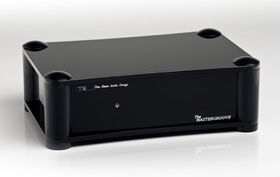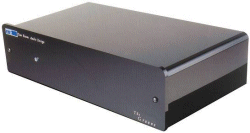Product Range: Tom Evans Audio Design
Master Groove
The culmination of all of our knowledge appears here in the form of the Worlds Reference Class Master Groove.
The sheer excitement of hearing a record for the first time is a once only occasion. However, image this; hearing your entire record collection with such exquisite detail, such open and transparent depth and soundstage and with such exacting and yet musical presentation that you truly believe that it as if you had never heard them before. Because until you have heard them through a Master Groove that is the truth of the matter.
If the effect of hearing instruments that you have never heard before from a piece of vinyl you believe you know inside and out, leaves you grinning from ear to ear, or crying in the absolute joy of the occasion, then prepare yourself for that very experience.

The Groove Phono Pre-amplifier
The Groove will re-write what you think is possible from vinyl. The phono stage happens so early in the process that it forms a gate that defines the performance of the entire system. What I?d assumed were the much trumpted shortcomings of vinyl were actually limitations in the phono circuits we've all been using. The Groove doesn't just open the gate, it takes it off its hinges, flattens the posts, tramples the walls and sets free the livestock. Dynamic range ? You?d better believe it. Musical coherence and inner detail ? In spades. Natural harmonic envelope? If it?s on the recording. In fact, limitations in the recording start to outweigh the limitations in the system; each and every track becomes a distinct and separate occasion. So choking is the influence of the average phono stage that I was shocked to discover The Groove redefined the performance potential of not just the whole system, but my record collection as well. - Hi-Fi Plus Magazine, Roy Gregory
If life is in the details, then the Groove certainly brings more life to the party than any other solid-state phono preamp I can remember. The Microgroove+ gets everything right, but the Groove simply does a better job of doing the disappearing act and letting the music through. If the Groove was just better in the midrange, for example, you could probably just use instead a cartridge (or cables, or preamp, or amplifier, or speakers) that provided that particular characteristic. But it is not that simple.
When you listen to a new component, those first 15 seconds are often more valuable in judging its sound than the hours that follow. While you may not clearly perceive every nuance of the change in performance, what you immediately notice are the gross differences between the new component and the one it just replaced. When I switched to the Groove, nothing jumped out and said "check out that great bass", or "the soundstage just got deeper". There was no particular area that focused my attention on it as a large change. Further listening revealed that there are small improvements in every area. But that initial impression, one that stayed for many hours, was one of a complete picture that had the ability to bring the musicians into the listening room with clarity, delicacy, and most importantly, believability.

The Groove + Phono Pre-amplifier
But the real significance isn?t in the blackness of the background itself, but in the contrast it provides for instrumental details and dynamics. The lack of noise and grain allows the subtlest of details to emerge, the individual colour and harmonics of an instrument, the precise timing and leading-edge of a note or breath. It is the fleshing out of the music with these micro-dynamic detail, hung on the precise temporal structure already provided by the standard Groove?s superb musical architecture that breathes life to every note, every instrument, every performance that passes through the Groove Plus.
It matters not how many records you play, the results remain the same. From the first note you hear to the last, each will be its own little revelation. The bowing of violin or cello, the strike of stick on drum, the catch in a voice or finger tips against strings: all are captured and caressed rather than imprisoned. The Connoisseur is without doubt the finest phono-stage I?ve heard. The Groove narrows the gap considerably, especially if (and like the Connoisseur) you use it with its matching line-stage. The musical journey that started with the Iso has come full circle. The Pulse finishes what the Groove began.

The Microgroove Phono Pre-amplifier
...Comparisons between the standard 'Micro-Groove' and the 'Plus' version are little short of astonishing, considering that the signal circuitry is identical. The Iso established itself as the benchmark for acceptable phono performance, a position that was never seriously challenged. The 'MicroGroove' comfortably inherits that mantle, but the 'Plus' is something else entirely. Compare the two and you'll I see what I mean; get used to the 'Plus' and you'll wonder how you ever found the cheaper models acceptable. So what does the Lithos regulator bring to the party, apart from a blue LED rather than the standard green one? In a word, clarity, but clarity in every sense. There's an obvious gain in transparency and solidity of the images, and the whole sound stage becomes far more defined and stable. But these are merely the most obvious symptoms. That improved definition applies to the leading edge of notes, their harmonic envelope and decay. In other words, the 'Plus' has far greater low-level accuracy, and here's the interesting bit; unlike most "accurate" hi-fi which generally sounds as dull as dish-water, the Lithos-ed 'MicroGroove' sound altogether more musical and involving. The dramatic increase in low-level resolution produces music that is full of immediacy, presence and sophistication.
Now the immediacy and presence are easy enough to understand, given the increased transparency and harmonic definition, but what's this sophistication? The increased definition of individual notes has clear temporal as well as spatial implications. Because we can now tell so much more clearly where individual notes start and how long they are sustained, the relationship between notes, and precisely where and how the musicians place them becomes much more apparent. This provides a direct insight into the chemistry of the performance, the interplay of the musicians, bringing the whole thing to life. Forget rhythmic integrity as an issue, here's the entire musical skeleton, clear to see. (For more on-this see the reviews of the Final Music amplifiers in Issue 2, and 'The Groove' in Issue 4.) The 'MicroGroove Plus' might not match the astonishing, almost master-tape solidity, presence and authority of its more expensive brother, but it gets you a fair way along the same road. In order to understand why that should be, it's necessary to appreciate exactly what the Lithos regulation achieves. Built from fifty discrete components onto a small pcb, the Lithos circuit is around a thousand times quieter and fifty times faster than the high quality Linear Technology 317AT/337AT ICs used in the standard 'Micro-Groove', and those are amongst the best conventional regulators available. The result of this is that not only does the circuit running from the Lithos regulator get power devoid of the overlaid ripples and distortion that the vast majority of signal circuits have to tolerate, but the circuit can react faster and to smaller signals, retaining their contribution and correct position in the overall picture. Its this that makes the 'Micro-Groove Plus' sound so stable and immediate, and makes it communicate the musical message so directly. It's this which moves you so much closer to the original performance.
If the 'Micro-Groove' establishes a new benchmark, then the 'Plus' sets the standard for others to aspire to. No it doesn't match the astonishing performance of 'The Groove', but then it doesn't cost ?1500 either. What you get at ?700 is enough of 'The Groove's attributes to seriously embarrass the (much) more expensive competition. You also get an immediate improvement in the performance of every record you own. Remember, the Lithos technology means that the 'Plus' provides performance potential that simply isn't possible from phono-stages using conventional regulation. This isn't just an upgrade, its a new set of rules. The standard 'Micro Groove' extends the Iso's reputation and is a very worthwhile evolution. The 'Micro Groove Plus' is a far more radical beast. It brings the revolutionary technology of 'The Groove' down to a far more affordable level, and lets you get there by stages too! Believe me, you really haven't heard what's on your records.

The Microgroove + Phono Pre-amplifier
The bass is excellent - tight but resonant. Bass strings vibrate with considerable realism and drums have great punch and weight. The midrange is rich but very well focused. Male vocals have a tangible, harmonic depth that is usually absent. The entire treble range has excellent resolution and is absolutely grain-free and very pure and open. Cymbals never sound like white noise, but ring true. The overall balance from deep bass to high treble is exceptional and "of a piece". Soundstage focus is spot-on. I will take a chance here and say that soundstage depth is just a gnat's wing shy of the better tubed units, although the Microgroove+ more than compensates for this with it's much lower noise floor. But honestly, this is reaching for something to criticize.
The Microgroove+ is consistently enjoyable and entertaining. I found myself turning up the volume and just being immersed in the music, and I always wanted to listen for longer than I could at the time. In every subjective parameter, this is an excellent product. One thought came to me again and again as I listened to this phono stage. If for some reason I had to get off the audio train and live with the gear on-hand right now, it would not be a problem. A good value at $1900? Absolutely, yes!
